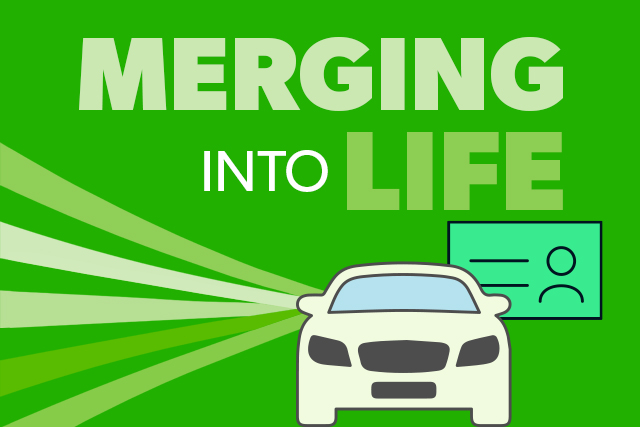SEASON 1: EPISODE 16
Episode Feedback
Driving test tips to help you prepare for the road ahead.
IN THIS EPISODE
Wondering how to pass your road test? We’ve got you covered. While fewer people are rushing to get their license right away, it’s still a major rite of passage.
This episode provides crucial driving test tips so you know what to expect. Listen as Linda Ricci, Assistant Manager at AAA Driving School in Rhode Island walks us through the basics of getting comfortable behind the wheel. We’re also joined by friend of the show Galen Olinski, who shares his embarrassing — but successful — story of becoming a new driver as an adult.
It’s time to get in the driver’s seat and get ready to ace those three-point turns!
KEY TAKEAWAYS
[6:17] – What are the benefits of learning from a licensed driving instructor?
[8:59] – How do you prepare for a driving test? We share what to practice before your road test.
[10:45] – How can I be confident for my driving test? Learn tips for getting over driving test anxiety.
[14:54] – Driving test do’s and don’ts and what to expect on your driving test.
TRANSCRIPT
[00:00:03]
Amanda Greene: Hey, Jenny.
[00:00:03]
Jenny: Hey, Amanda. How’s it going?
[00:00:05]
Amanda Greene: Pretty good, I guess. I mean, I just got back from the DMV. I almost let my driver’s license expire.
[00:00:12]
Jenny: Oh, no. Imagine if you had to take that test again.
[00:00:15]
Amanda Greene: No, that would be the worst. Bye, bestie. Welcome to Merging Into Life, where we navigate life’s milestones, one episode at a time. Brought to you by AAA Northeast. I’m your host, Amanda Greene.
Now that we’re well into season one, we would love to hear what you think. If you have feedback, ideas for an episode, or you just want to say hi, please leave a review wherever you listen, or email us at podcast@aaanortheast.com.
Today we’re going to talk about getting your driver’s license a little later in life. There are few things that signal adulthood like getting your license. I remember for me, I started the process the second I could. The moment I turned 15, I started taking these driver’s ed classes at school. I could not wait to get behind the wheel. It’s freedom, but times are changing.
According to the Federal Highway Administration, between 1995 and 2021, the share of teenagers with driver’s licenses declined by 24%. Fewer of us are rushing out to drive in the first few years we’re eligible, and there are good reasons for that. Getting a license can be pricey. Not everyone has access to a car to practice on, and teens in most cities can get around on their own just fine without a car. But just because you don’t start driving as a teen doesn’t mean you never will. Circumstances can, and often do, change over time. Take my friend Galen, for example.
READ MORE
[00:01:42]
Galen Olinski: For years and years and years I didn’t drive. I got around by taking buses. I got around by taking the subway. I would walk a lot. I would bike a lot. In some ways, it was kind of nice to not drive, to have to find other ways around.
[00:01:54]
Amanda Greene: But eventually, the time came.
[00:01:56]
Galen Olinski: After living in the city for about a decade, I found myself living in a very small rural town, which necessitated learning how to drive and getting a car. I began the process, had to take some more driving classes, and then took my driving test, which I failed the first time, embarrassingly. But I got it the second crack at it, started driving, and was still pretty freaked out as an adult driver, as I suspected I would be.
[00:02:23]
Amanda Greene: Why was that?
[00:02:24]
Galen Olinski: I think some of the differences between getting your license when you’re 17 versus getting it when you’re 30, first of all, you’re probably more intimidated by the risk of driving. You feel like you have maybe a bit more to lose when you’re a bit older, or you just are a bit more aware of the kind of calamities of life.
[00:02:41]
Amanda Greene: Learning new things can be challenging and at times, a little uncomfortable.
[00:02:46]
Galen Olinski: I had moved to the small town. I was a new teacher. I was on my way to work, and the thing that you’re afraid is going to happen happened. I turned a corner at an intersection onto oncoming traffic. I freaked out, and I pulled back into the intersection, and I realized I had pulled back into more oncoming traffic. I freaked out some more. I was probably screaming a lot. Then I drove to a parking lot of a gas station that was nearby, and I took a few deep breaths and composed myself, and then I drove to the school I was teaching at. When I arrived there that morning, there was a bunch of teachers sitting around having coffee before classes started. I sat down with them, and they were talking about bad drivers. One of the teachers said, ‘Yeah, and just this morning, I saw this idiot pulled into oncoming traffic, and then pulled back into the intersection.’ They were talking about me. I just made myself invisible and kind of chuckled with the rest of them and drank my coffee and ran away as fast as I could.
[00:03:48]
Amanda Greene: The teacher didn’t recognize you,
[00:03:50]
Galen Olinski: I just kind of giggled and disappeared. It was pretty rough.
[00:03:53]
Amanda Greene: That was a few years ago. What about now?
[00:03:55]
Galen Olinski: Now it’s great, drive all the time. Still not a great parallel parker.
[00:03:58]
Amanda Greene: Galen, thank you so much for sharing. I’m not surprised that learning to drive a little later in life isn’t easy, but despite a few bumps along the way, it’s doable. Let’s shake off those nerves and get behind the wheel, and there’s no better person to sit confidently in the passenger seat than Linda Ritchie. She’s an assistant manager at AAA Driving School in Rhode Island. She’s been in the industry a long time.
[00:04:24]
Linda Ricci: I actually got into driving because my dad was in driver’s ed and motorcycle ed, so I used to go with him and actually sit with him in his classes. It piqued my interest a lot.
[00:04:37]
Amanda Greene: You grew up surrounded by safe driving instruction. That’s perfect. Let’s start here, Linda, who is coming to your school to learn to drive?
[00:04:46]
Linda Ricci: We actually see anywhere between 16, and I think the oldest we’ve seen is 96, so we have seen the whole gamut. It really depends on what their needs are. Sometimes, the people who are older are coming to us for the first time, sometimes they need a refresher.
[00:05:05]
Amanda Greene: You really must come across so many different kinds of people who have different fears going into learning how to drive, and there are so many rules to learn and so many things to be aware of.
[00:05:18]
Linda Ricci: I look at every student as someone who’s going to learn and make it from that student who’s just stepping into your car, not having any idea of what they’re doing, to someone who’s going to be driving with you out on that roadway. You want to make them the best they can be while they’re with you.
[00:05:34]
Amanda Greene: What are the big differences between drivers who start the day they’re legally old enough to drive, and then people who decide to wait?
[00:05:42]
Linda Ricci: Basically, if you think about it this way, all the rules of the road apply to everyone. Learning is learning, and most people of any age are capable of driving. The difference is older drivers, they’re filled with more emotions, and when I say that, they get nervous. They’ve been out on the roadway with other people, and they’re more aware that there’s danger out there, where a 16 to eighteen-year-old, they know that there’s dangers, but they haven’t seen as much. Sometimes when you’re a little older, you don’t have anyone to practice with outside of the driving lessons, and the practice is what’s really key.
[00:06:17]
Amanda Greene: From all of your experience, do you recommend driver training? It seems like a rite of passage for teenagers, but how about as an adult?
[00:06:26]
Linda Ricci: I would say yes. I think driver training for any age is great even as a refresher because basically, you have a licensed instructor, and the licensed instructor can give you the rules of the road, the laws. They also give the encouragement and confidence, where if it’s a parent or guardian sitting next to you, there is more, unfortunately, the debate of who said it correctly, and they’re not going to listen as much. A licensed instructor, you’re going to listen to because they’re just the quote-unquote, stranger in the vehicle. They’re trained on all the rules of the road, but they also can train on the maneuverswith the maneuvers being parallel park, three-point turn, backing up straight, which are also part of what ends up being on the road test when you’re going to go from your permit to your license.
[00:07:14]
Amanda Greene: Linda, I only got docked one thing on my road test, and it was from my three-point turn. I didn’t use my blinker the whole time. I only turned my blinker on once. Every time you move the wheel, you’re supposed to turn your blinker on.
[00:07:28]
Linda Ricci: I kind of laugh at that because I’m thinking to myself, Amanda, what did you learn from that experience? I bet you never forgot your blinker again.
[00:07:35]
Amanda Greene: Never, never. It just wasn’t something that dawned on me. That was the only thing I got points off for.
[00:07:41]
Linda Ricci: That’s a great story to tell, and those are your bragging rights. That really means something to a student is, what did I do incorrectly? My hope is that they always learn something from it. I do want to add something about driver training, as well, because I also think that coming in from a licensed instructor perspective, they can give defensive driving tips which will stay with you. The licensed instructor also has a passenger brake, and we are able to give the student more confidence because we can slow the car down. Even if the instructor never touches that brake, it basically is there for safety of both people, and I think that students feel safer with the passenger brake.
[00:08:26]
Amanda Greene: Question about the passenger brake because I’ve always been curious. If the driver is accelerating, does your brake override theirs, or is it like a push-pull?
[00:08:36]
Linda Ricci: It is exactly like a brake. When I’m stepping on the passenger brake, it’s also pushing the driver’s brake down. If they accelerate, sometimes you do have to make an emergency procedure and throw the car into neutral. When I say throw the car into neutral, I’m just shifting from drive to neutral, and it’s neutralizing the gears in the car.
[00:09:00]
Amanda Greene: Okay. So how do you prepare for a driving test?
[00:09:03]
Linda Ricci: I think right before the test, the student should definitely, even the night before, run through any maneuvers that they know that are going to be on the test. That way, in your head, they have that pretty much down systematically; left directional, right directional, that type of thing. Also, know the car that you’re taking to the road test because let’s say I’m practicing in one car, and then I have to take a different car to the road test. At that point, now you need to make sure that you know where all the controls are. They usually are going to check the car for brake lights and headlights, all your directionals, your emergency flashers, where are they, make sure they work. Things like that going into the test. Once you’re on the test, one of the biggest things I want to say, and it sounds funny, but make sure you breathe because when you’re breathing, you’re actually thinking through everything.
[00:09:56]
Amanda Greene: Okay, what else?
[00:09:58]
Linda Ricci: Just little natural things that a normal driver would do, they’re going to be looking for on the test. Also, checking your mirrors, checking your blind spots, and checking what’s behind you. The examiner can see everything you’re doing. As the examiner is watching you, they’re watching to see if you’re actually checking your blind spots, which basically, you’re turning your head over your left or right shoulder, depending which way you’re moving, to check where the blind spot area is, or are you just moving your eyes. There’s a big difference between that. You actually want to move your head very quickly or for a split second, just over your left or right shoulder, but at the same time, it’s a very quick procedure. It’s not stand there and stare because that’s too long.
[00:10:45]
Amanda Greene: Learning something new can be hard. Do you have any advice or suggestions for people who might feel anxious or nervous about learning to drive?
[00:10:56]
Linda Ricci: I do. One of the biggest things is build up slowly. You might start in a parking lot, cemetery, maybe an industrial area where there’s some roadways but not too much traffic, and then go from there to a back road. Once you’re on the back road, and you’re comfortable, move up again to the next level, which would be roads with traffic, maybe single lanes, maybe multi-lanes. Once you’re more comfortable with that, now you move to a highway. One of the biggest things I would say is practice daily. Even if it’s for 10, 15 minutes, at least it’s practice. You want to practice on roads that are very familiar with you and then unfamiliar to you.
[00:11:32]
Amanda Greene: Can you walk me through the basics because I bet some of us seasoned drivers can become complacent when it comes to some important steps when you get into the car, when you’re preparing to drive?
[00:11:44]
Linda Ricci: Sure. The first thing you actually want to do is walk around your car, check your surroundings, see if there’s any fluid on the ground, check and make sure there’s no children or bikes, even piles of leaves because children can hide in leaves. You want to make sure that there’s nothing around your car. Once you get in your car, you want to lock your doors immediately. Then it comes to your seat position. Now sometimes, you can just jump in your car because you’re the only one driving it, but let’s say you share a car with someone else. You want to make sure that you adjust your seat correctly. Your left foot would be on your dummy pedal. Your right foot, your heel would be on the ground, and you would actually put your right foot in front of the gas pedal and be able to swivel it back and forth in front of the gas to the brake. That actually helps you, if there’s an emergency situation, you don’t want to ever pick up your foot, you always want to swivel it because there’s less time when you swivel your foot from the gas to the brake than picking up your foot.
[00:12:41]
Amanda Greene: What about your hands? Ideally, where do you put them?
[00:12:44]
Linda Ricci: I prefer nine and three, some people prefer eight and four. The other piece of it is you want your thumbs up along your wheel so that way your whole arm and your hands and your thumb stays out of the area of the airbag and your arms should be bent, not straight out, so you’re about 12 inches from the bottom of the steering wheel. Once you’ve set up all of your seat adjustments, and you feel comfortable, then you want to put your seat belts on. If you’re not familiar with the car, you want to make sure that you know your dashboard. Familiarize yourself with where everything is, and then make sure your adjustment with your mirrors is correct.
[00:13:20]
Amanda Greene: Keep your thumbs on the wheel to get them out of the way of the airbag. I’d never thought of that. These are really good tips. How about emergencies? What do new drivers need to know?
[00:13:32]
Linda Ricci: Probably one of the biggest things, if there is an emergency of any kind, and you can pull over to a breakdown lane on the right side of the road, and that way you’re always safe. You always want to pull to the right. The other thing is if there’s any, let’s say, police or fire, a tow truck, any kind of emergency vehicle that’s on the highway, you always want to move to the right as well and try to get out of their way. I know on the highway, sometimes it’s not as straightforward as that, but on the side roads, you always move to the right and you stop for them. If there’s a tow truck or fire truck or a police car at any point on the side of the road, there’s always a Slow Down, Move Over law. You want to slow down, and you want to move over if you can. That way you’re protecting the person in the emergency vehicle as well. One of the other things is a lot of people forget, if you’re pulled over by a police officer, whether it be day or night, it doesn’t matter, but at nighttime you always want to put on your light so that way they can see inside the car. You never want to move your hands so that they think that they’re going to be reaching for anything. You want to keep your hands visible at all times
[00:14:42]
Amanda Greene: After so many years, driving is second nature to me, but hearing all of this, there is so much to know. Let’s say the big day is here. We’re taking a driving test. What are some dos and don’ts?
[00:14:54]
Linda Ricci: Whether they’re going for a lesson or a test or even practicing with a parent, the same rules are going to apply. Really, they need to know upfront, they put their phone away, don’t even have it on. You want to know where your directionals are. You want to know what your headlights are. You want to basically know everything about your dash because they might ask you those type of questions before you even start moving. The other thing you want to do is make sure that you know how to do all the maneuvers, which usually it’s parallel park and three-point turn and backing up straight. Every rule that you have to do, that you would normally do as a driver, you’re doing during the road test as well.
[00:15:35]
Amanda Greene: Do you have any last thoughts for our new drivers out there?
[00:15:38]
Linda Ricci: Sure. I think really being patient with yourself and practicing as much as possible is one of the biggest things you can do. The second you feel frustrated, stop doing the training, walk away from it, and then come back to it again because practice is always building your confidence. When you have good basic skills, you become a lifelong defensive driver, which is really important because you’re driving with everyone else out there on the road and sometimes, they make mistakes. When they make the mistake, you have to figure out what you’re going to do about their mistake and how to keep yourself safe and your passengers.
[00:16:14]
Amanda Greene: We’re going to move on to a little rapid fire quiz here. Are you ready?
[00:16:18]
Linda Ricci: Sure. Yes.
[00:16:18]
Amanda Greene: Loud music while driving?
[00:16:20]
Linda Ricci: No.
[00:16:21]
Amanda Greene: Singing along to music?
[00:16:23]
Linda Ricci: My first gut feeling is no, unless you’re experienced.
[00:16:26]
Amanda Greene: Listening to podcasts in the car?
[00:16:29]
Linda Ricci: Again, probably the same answer. I would say no for a new driver, and then eventually, maybe after eight to 10 years, maybe it would be safe because now you’re more experienced.
[00:16:38]
Amanda Greene: Headphones on while driving, yes or no?
[00:16:41]
Linda Ricci: It’s illegal.
[00:16:43]
Amanda Greene: Taking extra time to properly de-ice and clear a snowy car?
[00:16:48]
Linda Ricci: Absolutely, it’s a must, and that is the law in most states.
[00:16:52]
Amanda Greene: Honking at a friend to say hello?
[00:16:55]
Linda Ricci: I would say no because that’s distracting.
[00:16:57]
Amanda Greene: Okay.
[00:16:58]
Linda Ricci: Unless you want to pull over and then say hello. I think that’s safer.
[00:17:02]
Amanda Greene: Okay. Amazing, Linda Ritchie. Thank you so much for coming on and sharing all things driving for the first time.
[00:17:08]
Linda Ricci: Thank you. Thank you very much.
[00:17:13]
Amanda Greene: If you’re new to driving, fear not. There’s a lot to learn, but with practice, you’ll get there. Don’t be shy to turn to the professionals. Having someone like Linda in the seat beside you will make a big difference, and enrolling in driving school may help lower your insurance. Safe driving. You’ve been listening to Merging Into Life, where we navigate life’s milestones, one episode at a time, brought to you by AAA Northeast with assistance from JAR Audio. I’m your host, Amanda Greene. If you’re learning as much as I am, follow us wherever you get your podcasts and leave a review. We would love to know what you think. Email us at podcast@aaanortheast.com. The views and opinions expressed in this podcast are not necessarily the views of AAA Northeast, AAA and/or its affiliates.
RESOURCES
AAA Driving School (available in Mass. And R.I.)
Want to Learn More? Drop Us a Note
"*" indicates required fields
*The views and opinions expressed in this podcast are not necessarily the views of AAA Northeast, AAA and/or its affiliates.









